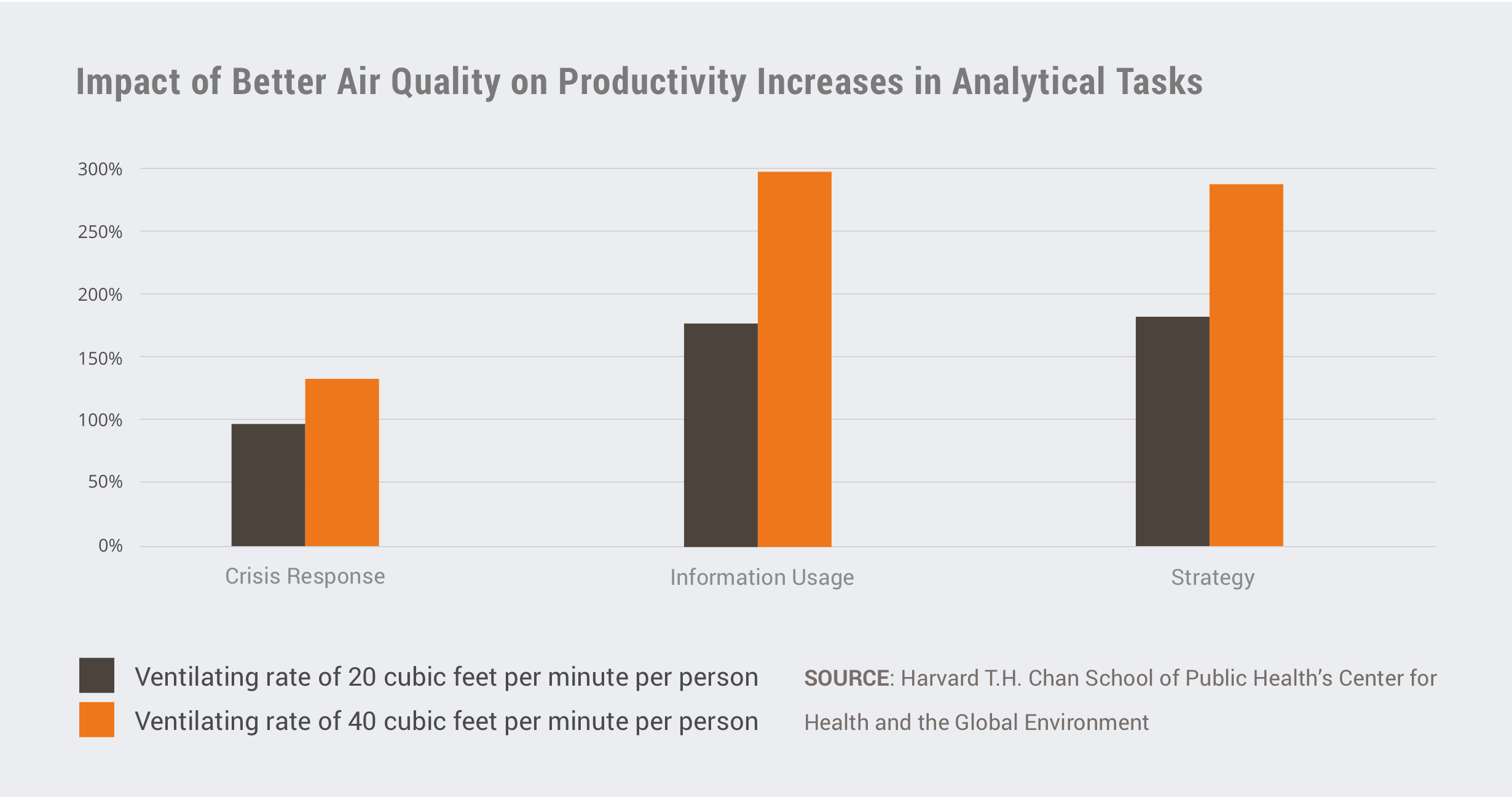RESET® Air
The RESET Air Standard is an indoor air quality standard focused on performance monitoring and real results.
RESET Air is designed to prioritize on-going results and long-term occupant health with a focus on the operational phase of the built environment. In the case of RESET Air, indoor air quality data is required to be continuously gathered through air quality monitors that measure the following parameters:
- Particulate Matter (PM2.5)
- Total Volatile Organic Compounds (TVOC)
- Carbon Dioxide (CO2)
- Temperature
- Relative Humidity
Results are streamed to the cloud and can be viewed in real-time from any computer or mobile device, informing occupants on the quality of the air in their spaces and buildings.
RESET Air takes a comprehensive approach to understanding the indoor air quality of an indoor space or building and is also designed to be scalable and affordable, while delivering actionable results.
The purpose of RESET Air is to use the collected data to provide projects with information that will assist in choosing the best solutions.
Download the RESET Air Standard1. What is the RESET Air Standard?
The RESET Air Standard defines the requirements for collecting indoor air quality data via continuous monitoring of an interior space or building, with the goal of standardizing indoor air quality data that is trusted, actionable, and relevant.
RESET Air takes into consideration aspects including monitor performance, deployment, installation, and calibration requirements, as well as data reporting and data platform requirements. The standard also sets targets for daily IAQ (indoor daily quality) performance that can be third-party certified.
RESET Air's fundamental approach to data requirements can be divided into 3 parts:
Completeness
RESET Air standardizes the continuous monitoring requirements of air quality in built environments. Continuous monitoring makes visible the invisible factor that impacts all indoor spaces in regards to health, productivity, and sustainability by using live data to highlight the changes in indoor air quality in real time.
The completeness of data verifies whether or not all the data is there and whether there is enough data to understand the state of indoor air quality.
Quality
RESET is first and foremost a standard for data quality. Air quality performance results are only as good as the data being assessed.
RESET addresses data quality at the source and specifies requirements for the monitors and the deployment methodology in a project. RESET also makes sure the data is trusted and relevant by requiring monitors to be installed in the right way and to have plans for long term maintenance. Lastly, RESET sets requirements for how the data is reported and connected to guarantee transparency and access via analysis and reporting.
The quality of data verifies that the data is true and reflects the actual situation.
Performance
RESET Air is performance-based and sets performance targets based on industry best-practices and international standards.
Acceptable targets are requisite for projects pursuing the RESET Air Project Certification, tracked through continuous monitoring and calculated into a daily average according to hours of occupancy. High Performance targets are listed as a reference for projects striving for more rigorous IAQ goals and/or for projects located in regions where ambient outdoor air quality levels typically stay within recommended health limits.
Performance Targets for the Commercial Interior Project Typology

Performance Targets for the Core & Shell Project Typology

*Note that if TVOC is in ppb, the equivalent to 500 ug/m3 and 400 ug/m3 is 220 and 176 ppb respectively. Learn more in the FAQ.
The RESET Air Standard is available for free and is publicly accessible. It is a great reference for any project that wants to good air quality in their space. Click here to download the RESET Air Standard.
Projects leveraging the RESET Air Standard can opt-in to becoming a RESET Air Project, where it can become RESET Accredited and Certified. Click here to read more information on project accreditation.
2. The Intent of RESET Air
We can survive for weeks without food and days without water. Yet, we can only survive a few minutes without air. Indoor air quality is nuanced, constantly changing, and not obviously detectable by human senses, but the impact of air quality on health is significant.
Continuous monitoring makes indoor air quality results actionable and helps protect the health of occupants.
Intent
The intent of the RESET Air Standard is:
- Promote the continuous monitoring of air quality in built environments.
- Standardize how indoor air quality performance is measured and communicated to make them comparable and benchmark-able.
- Advocate awareness and transparency around air quality by reporting the data to project occupants to foster education and promote social equity.
- Raise public awareness of indoor air quality and its impacts on environmental and occupant health.
- Gamify the data to create incentives for better air quality.
Health and Productivity
Healthy air can lead to less health issues and higher productivity. Exposure to bad air quality in and indoor environment can make people sick and miss work days. It can also lead workers to being less productive due to the effect of pollutants on cognitive function.

- Particulate matter 2.5 (PM2.5) refers to particles with diameter 2.5 µm or less. Exposure to high concentrations of PM2.5 can cause diseases in respiratory and cardiovascular systems.
- Volatile organic compounds (VOCs) are organic compounds that easily become vapors or gases. Common VOCs include formaldehyde, benzene, toluene, and styrene. Long-term exposure to VOCs can cause damage to the liver, kidneys, and the central nervous system.
- Carbon Dioxide (CO2) concentration has a direct impact on productivity and comfort. Elevated CO2 levels lead to drowsiness, dizziness and cognitive disfunction.
Learn more by downloading the 2.1. RESET Air Introduction in the downloads section.
3. How to Use the RESET Air Standard
With a focus on the collecting of data via continuous monitoring, the RESET Air Standard can be easily applied to either new or existing buildings.
The RESET Air Standard is applicable to two different project typologies, Commercial Interiors and Core & Shell, which have been separated to help tenants, operators, and owners achieve healthy performance targets by clearly defining and communicating their respective roles and responsibilities.

RESET Air for Commercial Interiors
RESET Air for Commercial Interiors (CI) is a performance-based standard targeting the air quality performance in interior spaces. It monitors, tracks, and communicates the quality of air breathed by the occupants of an interior space.
Download the RESET Air Standard for Commercial Interiors PDF. Download the RESET Air Certification Process for Commercial Interiors PDF.
Residential
RESET provides an alternate pathway for residential projects. Changes include the following:
- There are no occupant % calculations.
- There are mandatory requirements for sleeping areas.
- There are CO alarm requirements.

RESET Air for Core & Shell
RESET Air for Core & Shell (CS) is a performance-based standard targeting the air quality performance in mechanical air systems or HVACs. It monitors, tracks, and communicates the quality of the air being delivered to tenant and public spaces by the building’s mechanical air and HVAC systems.
Download the RESET Air Standard for Core & Shell PDF. Download the RESET Air Certification Process for Core & Shell PDF.
RESET is interested in exploring how to make RESET Air more nuanced so it can be better implemented and leveraged in other typologies. To do this, we need the help of smart and innovative partners to drive continuous monitoring into new territories, including typologies such as multi-family, restaurants, hospitals, roasteries, etc.
If you have a project that does not fit into these two project typologies, please reach out to us info[at]resetstandard.org.
4. Project Accreditation
On top of the RESET Air Standard, a project can pursue RESET Air Project Accreditation and Certification, which provides additional measures of trust via third party audits.
In order for a project to achieve RESET Air Project Certification, indoor air quality parameters, as tracked through continuous monitoring and calculated into a daily average according to hours of occupancy, must be maintained within the performance target limits during operation.
RESET Air Project Certification is a great way to market the excellent indoor air quality in a space and the long term positive effects. It is also an excellent way to start on other certification programs, with RESET Air being involved in a number of crosswalks, available here.
Click here to learn more about RESET Air ProjectsRESET Air Project Certification is not for the faint of heart. Achieving healthy air quality in an indoor space or in a building requires long term commitment to hardware, software, and upkeep and maintenance, making this certification one of the hardest in the world.
5. Other Accreditations
To optimize the process and to make sure that the data collected is of high quality, RESET Air has three other relevant accreditations.
Accredited Professionals
RESET Accredited Professionals (RESET APs) are expert advisors trained in the RESET Standards who provide this knowledge to project teams pursuing RESET.
To optimize the process, RESET APs are responsible, and required, for guiding project teams through the entire project accreditation and certification process.
RESET will not provide the service of guiding projects because we maintain the third-party auditor role.
To learn more about RESET APs, click here.
To see a list of the current RESET APs in the RESET Directory, click here.
Accredited Data Providers
Data Providers are responsible for collecting and aggregating the data according to RESET requirements, in addition to providing projects with a way to access the indoor air quality data in real time. The required data is to be collected and transferred to the RESET Cloud for assessment purposes.
To facilitate the process, projects pursuing RESET Project Accreditation or Certification must use a RESET Accredited Data Provider, who are already connected to the RESET Cloud for auditing and assessment purposes.
RESET will not provide data provider services and will maintain only the third-party assessment cloud.
For more information, please refer to the 2.8 RESET Air Accredited Data Provider Standard in the downloads section.
Accredited Monitors
RESET Air requires continuous monitoring of regularly occupied spaces. The accuracy of air quality monitors is of critical importance to determine how IAQ is impacting occupant health and to appropriately guide HVAC operations and maintenance. Market-available monitors range widely in quality, accuracy and reliability, therefore, RESET Air sets standards for sensor performance, maintenance, and calibration.
RESET Accredited Monitors, monitors which have passed our testing procedure (Section 2.7 in downloads), are required for a project pursuing RESET Project Accreditation or Certification. Only Grades A and B are acceptable for use in RESET Air Projects. Grade Cs are not acceptable.
RESET will not develop nor sell monitors and will only test and accredit monitors in the industry as a third-party assessor.
For more information, please refer to the 2.6 RESET Air Accredited Monitor Standard in the downloads section.
6. RESET Air Related Indexes
To help better digest the data collected while leveraging the RESET Air Standard, RESET has developed two indexes.
RESET Air Index
The RESET Air Index is a continuous monitoring air quality index that describes the optimization of a space based on RESET Air's performance targets.
Learn more about the RESET Air IndexRESET Viral Index
The RESET Viral Index is an index, leveraging continuous monitoring of air quality, that uses research on airborne viral transmissions to derive an algorithm to inform the optimization of a building's or indoor space's air quality and expresses it in one number.
Learn more about the RESET Viral IndexFor more information, please check out the RESET Initiative: RESET Viral Index.
7. RESET Air FAQs
Below is a link to the FAQ for the RESET Air Standard & Projects and a few other relevant links:
RESET Air FAQ
RESET Air Standard & Project Links
- RESET Air Standard
- RESET Air Projects Introduction
- RESET Air Projects Process
- RESET Air Projects Pricing Calculator
- Directory of RESET Projects
RESET AP Links
RESET Data Provider Links
- RESET Data Providers Introduction
- How to become a RESET Accredited Data Provider
- Directory of RESET Accredited Data Providers
RESET Monitors Links
- RESET Monitors Introduction
- How to become a RESET Accredited Monitor
- Directory of RESET Air Accredited Monitors
If you have any additional questions, please don't hesitate to reach out to us at info[at]resetstandard.org.
8. Download the RESET Air Standard v2.0
The RESET Air Standard v2.1 Draft is now available for preview. To view the Change Log and download the drafts, please click here.
All of the PDFs for the RESET Air Standard can be found below:
NOTE: 2.6. RESET Air Standard for Accredited Monitors and 2.7. RESET Air Test Procedure for Accredited Monitors are partially deprecated. For the latest information about the RESET Accredited Monitor requirements and process, please go to: RESET Air Accredited Monitor Process .